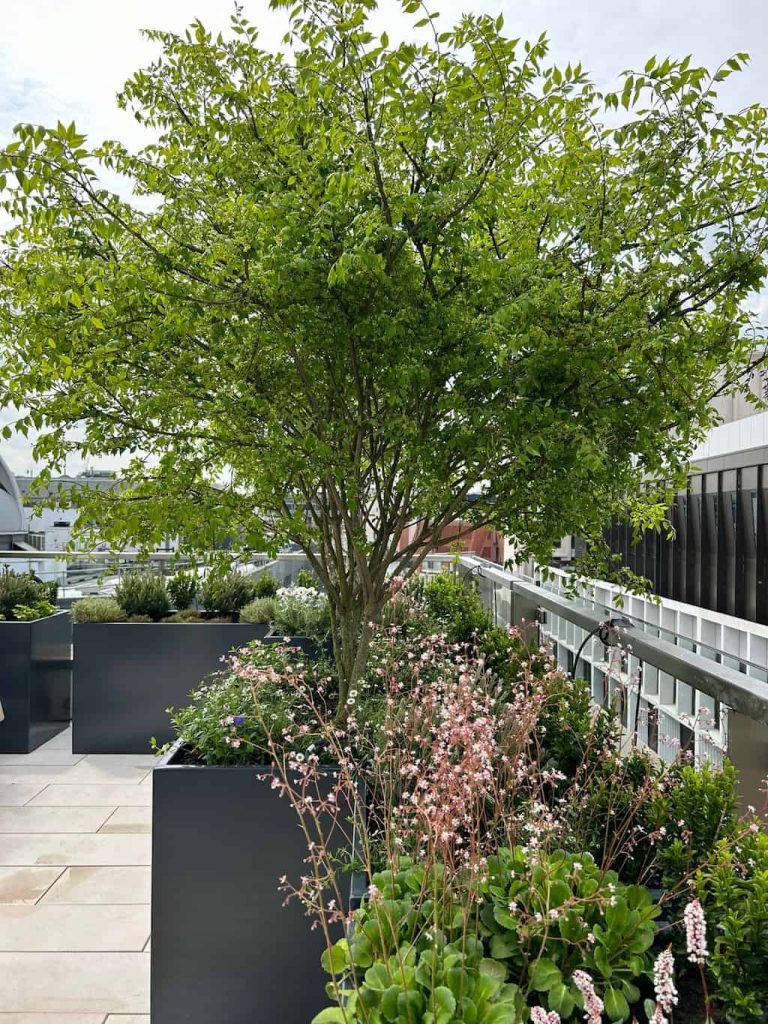A Guide to Planting a Tree in a Container
A Guide To Planting a Tree in a Container
Planting trees in containers offers an excellent solution for adding height or creating an interesting focal point within a small garden space. In this guide, we’ll provide some tips on selecting the ideal tree container, positioning it effectively, planting the tree, and ensuring proper aftercare.

Contents
Choosing the right tree planter
There is a wide range of different types of tree planters available in all different shapes and sizes. The most suitable tree planter will depend greatly upon the type and size of the tree that you are growing in your garden.
The most important consideration is how large you expect the tree to get over time, making sure there is plenty of room for growth in the container allowing your tree to flourish. It is also important to choose a container size that will give stability as you don’t want to risk your planter being blown over in windy conditions.
For those trees that are relatively large, it may be a good idea to select a tree planter without a bottom as this will allow the tree’s root system to access the surrounding areas easily and get all nutrients required to maximise growth. However, if you want to restrict the size of the tree or need to relocate it in future then it is best to select a planter with a base.
In terms of the shape of the tree planter to be selected, this is generally dependent upon the position of the tree within the garden and the style of garden that you are trying to create. Generally, if the tree is by itself in the middle of the lawn we recommend using circular planters as this helps to accentuate the tree within the garden.
However, in cases where the tree is in a repeating pattern, we recommend selecting cube planters as this provides greater formality and structure to your garden. The other key consideration is whether to select a planter with feet on the base.
The addition of feet on the base provides two distinct advantages the first is that it improves the level of drainage within the planter, which means that this type of plant is more suitable in areas of high rainfall. The other key advantage is that it makes it easier to use a truck to lift and move the planter around which makes it ideally suited for trees that need to be moved around or brought inside for winter.
Positioning the tree planter
Once the tree planter has been selected the next important step is positioning it in your yard. Generally, trees do best in warm, sheltered conditions, particularly when the tree is relatively young.
However, if the tree is planted in an exposed location where the conditions are relatively windy it is advisable to stake the tree when it is first planted to provide additional support.
It is also important to ensure that the location selected gets at least six to eight hours of sun per day as the vast majority of trees generally prefer full-sun locations. However, there are certain types of trees such as Japanese maples which do quite well in dapple shade as well.
For planters without a base, an important consideration is the quality of the soil in the area where the tree is to be planted. The vast majority of trees prefer rich, moist and free-draining soil with plenty of nutrients. Generally, locations where water will pool should be avoided as most types of trees will not do well in these conditions.
Planting the tree
Once the container and type of tree have been selected the next important step is to plant the tree. Most trees can be planted all year round however, in most cases the ideal time to plant a tree is in early to mid-spring just as weather starts to warm up.
The reason for this is that this gives time for the tree to establish a root system throughout the growing season before the cold weather hits in the following autumn and winter. An established root system will allow the tree to withstand the cold of winter more easily and provide a greater probability that it will survive.
For plants that are sold as bear-rooted trees, which include things like apples, pears, and stone fruit, it is better to plant earlier in the spring before the plant starts to produce flower buds. However, if the plant is sold in a pot it is best to wait until after the last frost.
When preparing your planter, ensure it has adequate drainage holes if it comes with a base. We recommend filling the first couple of inches with a layer of drainage aggregate to facilitate proper water flow and prevent waterlogging.
Additionally, a separation membrane is advisable above the drainage layer. This membrane helps to maintain the separation between the drainage material and the soil, and when used at the base of the planter, it can help to keep any dirt inside the container.
Trees in metal containers are particularly vulnerable to extreme temperatures. The roots near the container edges can overheat or freeze, affecting the tree’s health. If you are worried about this, consider installing insulation boards on the insides of larger planters. For smaller planters, you might relocate the tree to a more sheltered spot during extreme weather.
When planting the tree the key consideration is the growing medium which needs to be rich, moist, and free-draining to ensure that the tree thrives. To create a medium of this nature we recommend a multi-purpose peat-free compost.
The tree should be placed at a depth that is equal to the height that the plant was originally in the soil. In cases where the tree is grafted, it is important to ensure that the soil level is below the graft union to reduce the chances of the rootstock-producing shoots.
Once the tree is in position it is important to firm the soil around the tree as this will help to remove any air pockets in the soil. To ensure that the soil retains as much moisture as possible it is advisable to add a layer of mulch that is two to three inches thick.
When applying the mulch it is important to ensure that it does not come in direct contact with the trunk of the tree as this will encourage collar rot.
Tree planter care
Trees in containers dry and much faster than those in the ground. To ensure that the tree remains healthy on an ongoing basis it is important in the first season, in particular, to water the plant regularly particularly at the height of summer when the weather is relatively warm.
In addition to this, the other important factor is to ensure that the tree has sufficient nutrients. This can be achieved by giving the tree a slow-release fertiliser once a year which is usually applied at the start of the growing season, at the same time it’s also a good idea to scrape off the top layer of compost and replace it with fresh to help give the tree a boost.
The next important job is to ensure that the tree is pruned regularly to create a desirable shape and encourage growth. To maximise the growth rate of the plant it is best to prune it at the end of the growing season or in winter as this will encourage rapid growth in the following spring.
In the case of trees that are grown in containers with a base, it may be necessary every 3 to 5 years to remove the tree and add additional compost to refresh the plant.
If you follow these steps you will end up with a healthy-looking tree in a beautiful planter that will last for many years. Explore our diverse range of metal tree planters to find the perfect option for your tree.
